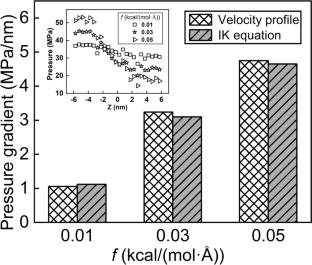Boundary slip moderated by interfacial hydrogen bond dynamics
Abstract
Understanding the slip behaviors on the graphene surfaces is crucial in the field of nanofluidics and nanofluids. The reported values of the slip length in the literature from both experimental measurements and simulations are quite scattered. The presence of low concentrations of functional groups may have a greater impact on the flow behavior than expected. Using non-equilibrium molecular dynamics simulations, we specifically investigated the influence of hydroxyl-functionalized graphene surfaces on the boundary slip, particularly the effects related to hydrogen bond dynamics. We observed that hydroxyl groups significantly hindered the sliding motion of neighboring water molecules. Hydrogen bonds can be found between hydroxyl groups and water molecules. During the flow process, these hydrogen bonds continuously form and break, resulting in the energy dissipation. We analyzed the energy balance under different driving forces and proposed a theoretical model to describe the slip length which also considers the influence of hydrogen bond dynamics. The effects of the driving force and the surface functional group concentration were also studied.


 求助内容:
求助内容: 应助结果提醒方式:
应助结果提醒方式:


